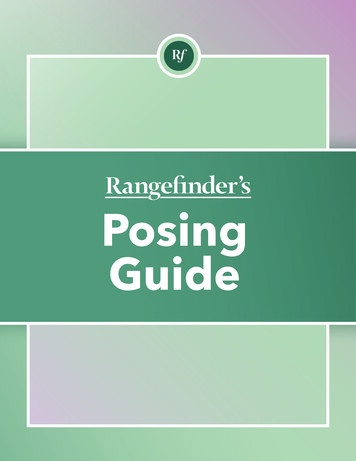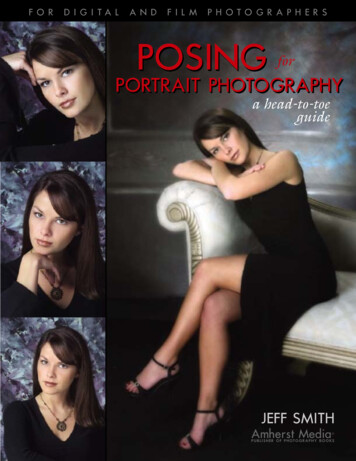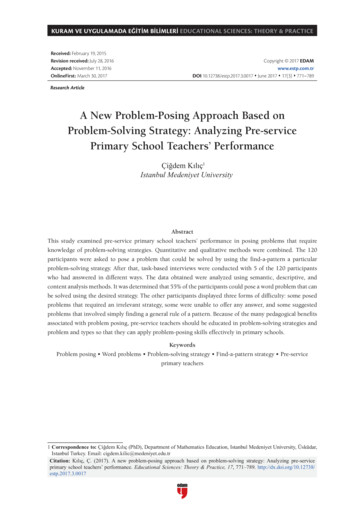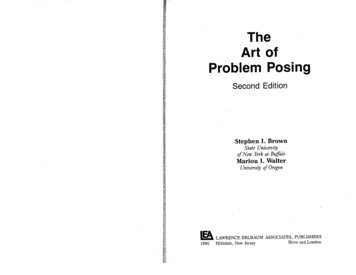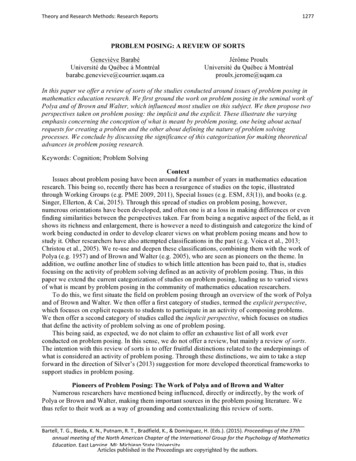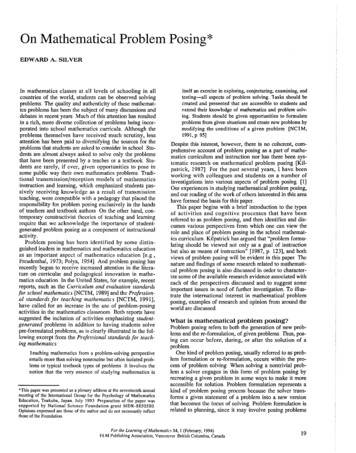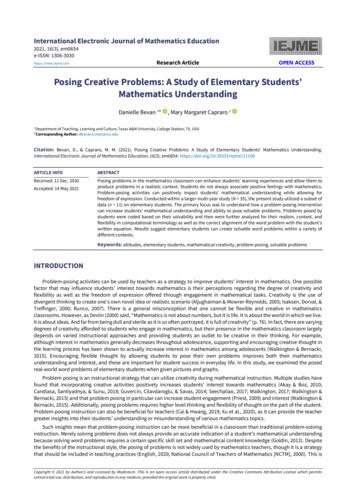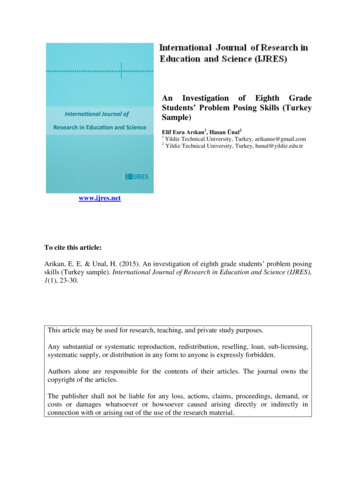
Transcription
Mind, Culture, and Activity, 21: 148–170, 2014Copyright Regents of the University of Californiaon behalf of the Laboratory of Comparative Human CognitionISSN 1074-9039 print / 1532-7884 onlineDOI: 10.1080/10749039.2013.878361Posing the Question: Visitor Posing as EmbodiedInterpretation in an Art MuseumDownloaded by [Mr Andy Blunden] at 18:00 16 May 2014Rolf SteierUniversity of OsloThis article identifies and explores posing by visitors to an art gallery as a unique meaning makingactivity. Conducted as a design experiment in partnership with a national art museum, this studybuilds on theoretical perspectives related to gesture and embodiment. Empirical findings suggestthat particular posing activities function simultaneously to mediate internally and externally orientedprocesses of interpretation in encounters with art. Accordingly, these complex posing practicesmay be viewed as an integrated part of visitors’ meaning making experiences. Implications forthis research include expanding our understanding of the roles of the body in visitor’s museumexperiences.INTRODUCTIONPosing with art is a largely unexplored yet significant aspect of the cultural practice of participation at museums. Around the world, we commonly see visitors and tourists posing in frontof statues, paintings, or other monuments or works of art. On a near daily basis, when passingthrough the famous Vigeland Sculpture Park in Oslo, I see visitors posing for a friend with a camera, mimicking and gesturing with the statues. Just as a museum visitor turns her camera towarda friend’s pose in front of a famous piece of art, we too must shift focus to the phenomenon ofposing with art. These behaviors are not new themselves, but trends in social media have madethem particularly visible—both as a way of documenting and sharing these interactions and as aform of participation with these places. But what is happening when visitors pose? How can weunderstand these behaviors as interactions with art and as social phenomena?Jaworski and Thurlow (2009) specifically explore such tourist performances as behaviors that,in coordination with a variety of semiotic resources, fundamentally shape a sense of place andidentity for tourists. Such performances, although not strictly the subject of this article, are aCorrespondence should be sent to Rolf Steier, University of Oslo, Department of Education, P.O. Box 1161, Blindern,Oslo 0318, Norway. E-mail: rolf.steier@intermedia.uio.no
Downloaded by [Mr Andy Blunden] at 18:00 16 May 2014POSING THE QUESTION149useful starting point for demonstrating the pervasiveness of these acts of posing with art andother cultural artifacts.Only quite recently have art museums begun to build these patterns of use into visitorexperiences. The exhibit presented in this study invited visitors to engage with the self-portraitgenre by posing and comparing their own compositions. The Cleveland Museum of Art hasrecently introduced an interactive exhibition in which visitors are invited to make facial expressions and poses, which are in turn connected to similar works in the gallery through body andfacial recognition software (Alexander, Barton, & Goeser, 2013). Although the practice datesback over a century, tableaux vivantes (living pictures) have more recently been embraced asan elementary school activity in which groups of students dress up and pose to depict historicalscenes from paintings (Hurwitz & Day, 2007). Anatomy exhibitions of preserved human bodies have toured science centers around the world in the past decade, and have drawn attentionto visitors’ physicalities. Vom Lehn (2006) examined visitors relating their own bodies to thosein one such exhibit. He demonstrated that “the bodily actions of the participants are critical forhow they each view the exhibits” (p. 235). By pointing and orienting their bodies to the objectson display, visitors made comparisons with those in the exhibit. Vom Lehn writes that visitors“discover certain aspects of an exhibit, transpose them onto their body and then talk about it inthe light of the discovery of the exhibit feature” (2006, p. 243).In this article, I attempt to extend current understandings of visitor meaning making processesin art museums by incorporating aspects of the physical experience. Specifically, I identify certainposing activities as embodied action related to particular forms of gesture. These poses mediate the intertwined processes of social interaction on the intermental plane and psychologicalprocesses on the intramental plane (Vygotsky, 1978; Wertsch, 1985, 1998). I argue that theseprocesses may be understood as central to meaning making.Making Meaning in Art MuseumsHistorically, research on interpretation in art history (as opposed to meaning making in artmuseum settings) has been grounded in perception-oriented perspectives focused on an individualviewer (Pierroux, 2006). Information-processing research is similarly concerned with modelingcognitive aspects of visitors’ perceptual processes in art interpretation, often studied in controlledsettings (Leder, Belke, Oeberst, & Augustin, 2004). However, such a focus on individual mental processes does not account for the social, institutional, and mediational role of other actors,contexts, and resources.In contrast with models of individual interpretive processes, this study is grounded in a sociocultural perspective on meaning making. An individual’s meaning making processes are situatedin overlapping personal, physical, and sociocultural contexts (Falk & Dierking, 2000). In artmuseums, these processes may be understood as forms of participation by visitors with tools,symbols, activities, and people (Piscitelli & Weier, 2002; Schauble, Leinhardt, & Martin, 1997).Knowledge, thus, involves the ability to participate in these contexts (Leinhardt & Knutson,2004). According to sociocultural theory, meaning potentials are embedded in cultural tools suchas language and concepts that mediate human thinking and activity (Vygotsky, 1978; Wertsch,1985). Pieces of art thus cultural objects embedded with meaning potentials developed in particular social and historical contexts (Bakhtin, 1986; Pierroux, 2003). Language and gesture are
Downloaded by [Mr Andy Blunden] at 18:00 16 May 2014150STEIERamong the cultural tools that mediate visitors’ situated interactions with art and with one another,as are art historical concepts and information provided in texts, labels, and technologies in thegallery spaces. For young people, meaning making in art museums involves processes of understanding the skills and techniques of the artist and relating their own ideas, feelings, and personalhistories with those of the artist (Pierroux, 2005; Piscitelli & Weier, 2002).Studies of museum meaning making that are grounded in a sociocultural perspective oftenfocus primarily or exclusively on visitor talk with the visitor’s body backgrounded (Allen, 2002;Hohenstein, 2006; Knutson & Crowley, 2010; Leinhardt, Crowley, & Knutson, 2002; Pierroux,2003; Stainton, 2002). These studies demonstrate the significance that words and language playin visitor meaning making. Alternatively, studies of gesture and body in museums often focuson social coordination and not meaning making processes. In particular, discussions of gesturetypically focus on its communicative role in social interaction in museums. For example, visitorsmay use pointing gestures to direct each other’s attention in an exhibit (Ash, 2004; vom Lehn,Heath, & Hindmarsh, 2001). These studies often treat gesture primarily as a communicative tool,that is, as externally oriented symbolic action.However, meaning making can be thought of as occurring on both internal and externalplanes (Vygotsky, 1978; Wertsch, 1985). Externalization processes are socially visible displays of symbolic meaning. Internalization processes explain how these external representationsdevelop in cognition. These psychological processes of internalization and externalization aredialectically related (Vygotsky, 1978; Wertsch, 1985, 1998). The limited research that hasaddressed the visitor’s body in museums has not accounted for the complexities of the simultaneous and overlapping internal and external orientations of the body in situated action. As isexpanded below, this article refers to a pose or gesture as externally oriented when its primary role is communicative and intended to display meaning for another person. Internallyoriented posing is directed toward the self and coordinates conceptual work of the individual(Streeck, 2009b). This study expands on this research by exploring the mutually constituted relationship between internally and externally oriented aspects of posing (as one typeof physical experience) and their relationship to processes of meaning making in encounterswith art.The setting for this research is a museum installation that was part of a larger design experiment conducted through a partnership with a national museum of art. This project consisted ofthe design, installation, and research of an interactive space that aimed to engage young peoplein the work of Edvard Munch and art concepts in general. Video recordings of teenage visitors’interactions in the gallery space, and with one of four interactive stations in the project room,compose the main empirical material. The station is titled My Self and was designed to engagevisitors in learning about Munch’s self-portraits and the self-portrait genre. Visitors were encouraged to recreate the self-portraits by posing and taking pictures. Using multiple sources of videodata collected at the gallery, interaction analysis methods (Derry et al., 2010; Hall, 2000; Jordan& Henderson, 1995) were applied to the investigation of visitor experiences in both the existinggallery space and the designed project room. Through this study, the following research questionswere addressed: What is occurring when visitors pose with artwork in a museum? More specifically, what is the nature of the relationship between internally and externally oriented aspectsof posing? And how might acts of posing relate to visitor meaning making processes in artmuseums?
POSING THE QUESTION151PERSPECTIVES ON EMBODIMENT, GESTURE, AND POSINGAlthough there are many forms of posing, I am particularly interested in the art museum context,and I treat posing as a socially situated interaction with an artwork. Posing occurs when a visitorattempts to mimic or re-create a figure from a piece of art with their body. In the followingsection, I conceptualize posing in relation to ideas of embodiment and gesture. Within the arenaof gesture, I identify key forms of gestural practice to interpret these activities. I then establishposing with art as a unique meaning making activity worthy of investigation.Downloaded by [Mr Andy Blunden] at 18:00 16 May 2014Posing as Embodied ActionThe concept of embodiment has gained currency in recent years, particularly in light of new formsof interaction and engagement with technology. This perspective offers a promising starting pointfor conceptualizing activities of posing, in particular the relationship between the physical actionsof the body and meaning making processes (e.g., Cheville, 2006; Dourish, 2004; Farr, Price, &Jewitt, 2012). Merleau-Ponty’s (1945/1974) notion that the body is central to all interactions andknowing in the world aligns with this article’s exploration of the body in museum experiences.In treating acts of perception as physiological as well as psychological (1945/1974; Joy & Sherry,2003), Merleau-Ponty also establishes a starting point for approaching acts of posing in relationto visitors’ aesthetic experiences. This emphasis on the physical was also the basis of Lakoffand Johnson’s (1999) examination of the concept of metaphor, which showed how people relatephysical experiences into abstract concepts and ideas. These metaphors develop into abstractconcepts as children develop and allow people to communicate with and think about abstractconcepts (Farr et al., 2012). However, the embodiment concept may be too broad on its ownto be helpful in analyzing the meaning making aspects of the activity of visitors posing in anart gallery. Goodwin (2000) writes that, “rather than locating a homogeneous field for analysis,the notion of embodiment encompasses many different kinds of phenomena” (p. 1519). Thesemay include orientation, gesture, and intonation, among other physical aspects of interaction.Accordingly, we can interpret posing with art as one such phenomenon within a framework ofembodied interaction—situated within and interrelated to a variety of aspects of embodiment.However, to understand the complex processes of posing in a museum, an analytic framework isneeded. Thus we turn to gesture, as a form of embodied action.Posing as GestureGesture is a semiotic system for socially coordinated action and thought, much like verballanguage (Goodwin, 1986; Kendon, 1983). Through conversation analysis, Goodwin (1986) illustrates the ways in which gesture functions as a complimentary semiotic system to talk. He writes,“In brief, gesture is not simply a way to display meaning but an activity with distinctive temporal, spatial, and social properties that participants not only recognize but actively use in theorganization of their interaction” (Goodwin, 1986, p. 47). Gestures are not simply stand-alonerepresentations of meaning but function as a reflexive and dynamic display that exists as a fundamental component of human interaction (Goodwin, 2000). Meaning is not presented by gesturebut develops, in part, through gestural interaction.
Downloaded by [Mr Andy Blunden] at 18:00 16 May 2014152STEIEROne influential framework is that of McNeill (1992), which identified four categories ofgesture—beat, deictic, iconic, and metaphoric. Beat gestures do not display content but insteadare used to provide emphasis or denote time in structuring communication. Deictic gesturesinvolve pointing and are thus heavily context dependent. Iconic gestures are defined as havinga perceptual resemblance to an object of speech or interaction. Similarly, metaphoric gesturespresent a perceptual relationship, but instead refer to an abstract object or content (McNeill,1992).All of these functions would be potentially useful to an analysis of interactions in art museums,but I wish to focus on iconic gestures as they appear most directly relevant to posing activities.The central feature of iconic gestures is this relationship of visual similarity. For McNeill (1992),the iconicity is dependent on the relationship between the gesture and the accompanying talk.Goodwin (2003) expands this relationship to include both talk and the visible phenomena. Thatis, there exists a perceptual relationship between a gesture, and either or both of the accompanyingspeech and phenomena.These possible relationships of gesture–speech and/or gesture–phenomena have implicationsfor investigations into the role of iconic gestures in multiple learning contexts. For example,young children produce iconic gestures as they develop verbal language (Goldin-Meadow &Alibali, 2013). Similarly, Hostetter, Alibali, and Kita (2007) experimentally demonstrated thisrole of gesture in concept formation by having subjects describe images containing various levelsof abstraction. They found that subjects gesture more when describing more abstract images andvocalize more when the images are less abstract. In physics classrooms, students were shownto produce iconic gestures while manipulating physical representations in instances where theylack the scientific language and concepts to express themselves verbally (Roth, 2002; Roth &Lawless, 2002). In categorizing the gestures used by a biology teacher in relation to pictures, Rothand Pozzer-Ardenghi and Roth (2004) demonstrated how iconic gestures function to emphasizeparticular features of an image.As evidenced by the breadth of these findings, the label of “iconic gesture” typically doesnot distinguish between gestural depiction (for others) and gesture as conceptual action (for theself; Stre
Accordingly, we can interpret posing with art as one such phenomenon within a framework of embodied interaction—situated within and interrelated to a variety of aspects of embodiment. However, to understand the complex processes of posing in a museum, an analytic framework is needed. Thus we turn to gesture, as a form of embodied action.


